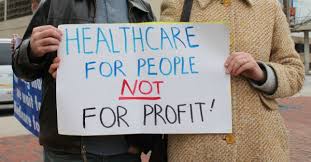
It’s likely that over $10 billion will be spent on political campaigns in the 2023 – 2024 election cycle. The bulk of this money comes from wealthy individuals and corporations. This skews our public policies and the enforcement of our laws to favor their special interests because they do expect to get something in return for their investments. Most Republicans and even some Democrats oppose efforts to limit campaign contributions.
(Note: If you find my posts too long to read on occasion, please just skim the bolded portions. Thanks for reading my blog! Special Note: The new, more user-friendly website for my blog is here.)
As we enter the 2024 presidential election year, money is once again, of course, flooding into candidates’ campaigns. It’s no surprise that, with all the money wealthy individuals and corporations are putting into campaigns, public policies and the enforcement of our laws are skewed to their special interests. A key cause of the growing flood of money is the 2010 Citizens United U.S. Supreme Court decision (and related ones) that have equated the spending of money in political campaigns with the right to free speech and have given corporations free speech rights like those granted to human beings by our Bill of Rights.
Although the presidential election year has just begun, huge amounts of money have already flowed into presidential candidates’ campaign coffers. Including each candidate’s campaign committee as well as any super political action committee(s) (PACs) or other “outside” group(s) dedicated to supporting the candidate, the major candidates have already raised the following sums: [1]
- Biden $147.5 million
- Trump $139.5 million
- Haley $105.4 million
- Kennedy $ 0 million
There typically is at least one super PAC or outside group supporting any serious presidential candidate. These groups can raise and spend unlimited amounts of money and some of them work hard to obscure who their donors are (e.g., through “dark money” groups). Legally, PACs and outside groups are supposed to operate independently of the candidate’s committee, but this is true only in theory. They’re often run by former staffers, friends, or even family members. They sometimes share office space or consultants with the candidate’s campaign. Increasingly, these supposedly independent entities are taking on some of the duties traditionally handled by the candidate’s campaign, such as organizing town hall meetings or doing voter outreach. This is happening because currently there’s effectively no enforcement of the requirement for independence as the Federal Election Commission has largely been emasculated by political gridlock.
The political parties are, of course, also raising money. The Democrats and Republicans each have three major committees, a national one, a Senate one, and a House one. The combined fundraising totals for the three committees are: [2]
- Democrats $315.5 million
- Republicans $262.8 million
Campaign fundraising will, of course, increase during this election year. It’s likely that each side will spend over $1 billion on the presidential race alone. This is a staggering amount of money and the wealthy individual and corporate donors do expect to get something in return for their investments. Therefore, their money skews the policy topics and alternatives that are on the table for consideration, as well as which ones are enacted and how laws are enforced (or not).
For all federal elections (not just the presidential race), outside spending is greater than it’s ever been. Super PACs and other outside groups have already spent almost $318 million on the presidential and congressional races. This is over six times what had been spent at this point in the last presidential election cycle in 2020. An advertising analyst is predicting that over $10 billion will be spent on political advertising in the 2023 – 2024 election cycle. [3]
Most Republicans and, unfortunately, even some Democrats oppose efforts to limit campaign contributions. Elected officials have successfully used the current system to get elected and the large contributions of wealthy individuals and corporations are typically what got them into office and will keep them there, whether they’re Democrats or Republicans.
Recently, in Virginia, Democrats who control the General Assembly quietly killed a bill that would have limited campaign contributions. Virginia is one of five states with virtually no limits on campaign contributions. Although three-quarters of voters in Virginia – including strong majorities of Democrats (82%) and Republicans (67%) – support contribution limits, bills to do so make no progress in the legislature.
The recent legislation that was killed would have limited individuals’ contributions to Senate and statewide candidates to $20,000 and to $10,000 for House candidates. Typical contribution limits for individuals in other states are between $2,000 and $4,000, and are $3,300 at the federal level. Even these amounts are much more than the average voter can or will contribute. So, the proposed Virginia limits were quite high, but still weren’t acceptable to Democratic legislators there. Overall, campaign contributions for legislative candidates in Virginia have grown from $39 million in 1989 to $191 million in 2023 (after adjusting for inflation). Dominion Energy, the state’s largest publicly-regulated electric utility, was the largest contributor in the 2023 election cycle, giving $11.5 million to candidates and party committees, including almost $700,000 to the Democratic House Speaker. This money is buying access if not outright influence. [4]
Massive campaign spending corrupts our democracy. Many elected officials are beholden to wealthy donors, individuals and corporations. The effects on our government and its policy making are both blatant and subtle, but we certainly do NOT have a democratic government that’s truly of the people, by the people, and for the people.
[1] Open Secrets, retrieved 2/18/24, “2024 Presidential Race,” (https://www.opensecrets.org/2024-presidential-race)
[2] Bryner, S., & Glavin, B., 2/1/24, “Three takeaways from 2024 presidential candidate filings,” Open Secrets (https://www.opensecrets.org/news/2024/02/three-takeaways-from-2024-presidential-candidate-campaign-finance-filings)
[3] Massoglia, A., & Cloutier, J., 1/16/24, “Outside spending on 2024 elections tops $138 million,” Open Secrets (https://www.opensecrets.org/news/2024/01/outside-spending-on-2024-elections-tops-318-million/)
[4] Cloutier, J., 2/16/24, “Virginia state lawmakers quietly killed a bill to limit campaign donations,” Open Secrets (https://www.opensecrets.org/news/2024/02/virginia-legislature-killed-a-bill-to-limit-campaign-donations)
